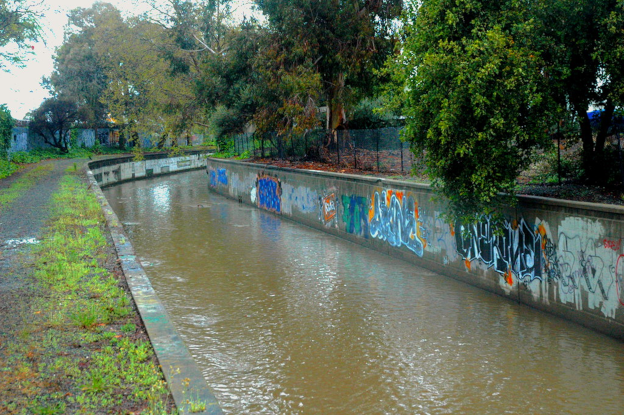At the summit, the BAAQMD’s David Ralson described three examples of redoing infrastructure to break down barriers separating human ecology and the natural environment. Three such initiatives are underway in the area around San Leandro Bay, the locale of RBD’s Estuary Commons project. “The I-880 corridor from High Street to 98th Avenue contains the worst-off disadvantaged communities in the Bay Area in terms of health outcomes,” he said. “They are also subject to sea-level rise and groundwater inundation.”
Former wetlands are now filled with gray infrastructure. Hidden urban creeks, like San Leandro/Lisjan Creek, offer a pathway to reconnection: “People will say, ‘We don’t know about this creek; we don’t have access.’ But their grandparents may have fished or played in the creek.”


Merritt College students, the Indigenous-woman-led Sogorea Te’ Land Trust, and others are working to reclaim the creek as a sanctuary. However, the vision of a riparian greenway trail is threatened by plans for a high-speed Capitol Corridor rail line through the neighborhood: “The railroad is refusing to allow a path to go underneath to connect the schools and the neighborhood to the waterfront. If we can’t get people to the waterfront, it’s not doing us any good,” said Ralston.
In East Oakland’s Columbia Gardens neighborhood, Brookfield Elementary School sits next to the freeway, with a power transmission line over its playground. Groups like Higher Ground are planting a vegetation buffer along a 400-foot stretch of freeway to mitigate air and water pollution.
A third project envisions pedestrian and bike bridges over 880, providing access to the Martin Luther King Regional Shoreline. That, Ralston acknowledges, will be expensive: “We’re trying for state and federal funds to make it happen.” It will also require working with CalTrans, an agency that he says is “taking a new tack on realizing equity and trying to heal some of the trauma of those huge infrastructure projects.”
Summing up, Ralston described a “confluence of opportunities” for equitable innovation: “Green, living infrastructure—it’s about connecting the dots between people and the centers that make them alive.” He saluted another hero, the late community and environmental activist Whitney Dotson, “an inspired fighter” who helped save a Richmond marsh from industrial development. Dotson’s lesson: “You have to stay on the ball.” JE